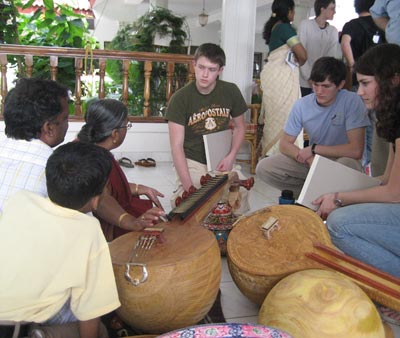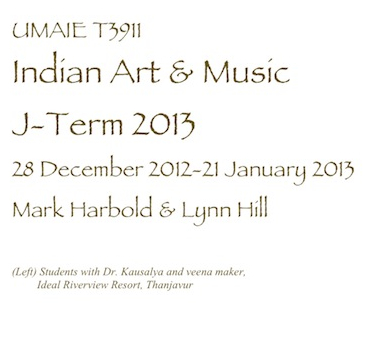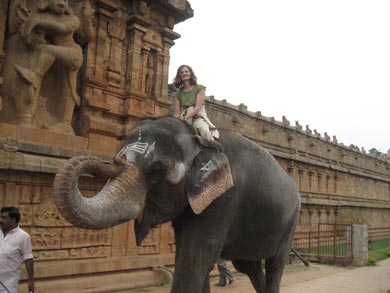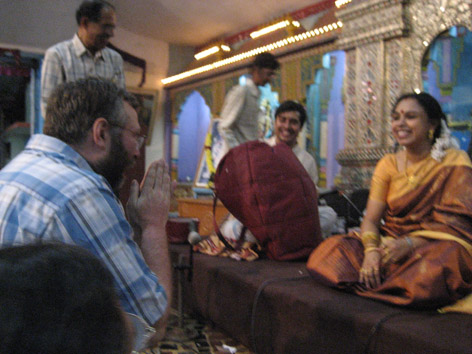

 |
 |
Indian Art & Music Home Page | |||||
|
|
|
|
|||
|
|
|
||||
| Tentative Day-by-Day Schedule Page | Syllabus Page | ||||
| Contact Lynn for more info | Contact Mark for more info |
|
|||
|
|
|
|
|
|
|
|
|
Indian Art and Music is an “up close and personal” interdisciplinary study of the art, architecture, and music of India in their historical, religious, classical, folk, and popular contexts. |
| Space is still available – Apply NOW to guarantee a seat! Click here for more registration info! |
|
Madras Christian College—Chennai Folk dances at Martin Hall, new saris at the guest house, EC students “posing” at traditional-style dinner | ||
|
Tentative Itinerary |
Overall Cost TBD ($6,450-$6,750) |
|
|
| Back to top |
|
Tyagaraja Festival—Tiruvaiyaru (near Thanjavur) Early morning procession, festival grounds at night, hundreds of musicians sing St. Tyagaraja’s Five Jewels |
||
| Course Description |
|
| Back to top |
|
Mamallapuram Dance Festival—Mamallapuram (Mahabalipuram) Beach resort at dawn, Shore Temple (World Heritage Site), dancers in front of Arjuna’s Penance | ||
|
Registration & Other Practical Matters |
|
| Back to top |
|
The Taj Mahal—Agra Eastern facade, from the south (with Lynn Hill), Shah Jahan’s view from Agra Fort | ||
| Travel Safety & Comfort |
|
Rest assured we will do everything possible to insure your safety in India. The following may help you make an informed decision: |
Bring clothes for different climates! Our time in South India will be delightful—mid- to upper 80s F. (30 C.) and sunny every day! (No matter how hot, please dress modestly if you want to be treated respectfully by Indians!) Delhi will be a different matter. Temperatures can range up to the low 60s F. (16 C.) in January, but if they have a cold spell the high temperature might be only 50 F. (10 C.) and we could see rain and fog. Hotels, buses, etc., will often not be heated, so dress accordingly. Even under the best of circumstances, travel in India can be strenuous. India’s ADA-style regulations are not as comprehensive as ours, and in many locations you will need to climb stairs, often with your luggage—a good reason to travel light! Some sites require vigorous hikes over difficult and/or hilly terrain (often without toilet facilities). |
| Back to top |
| About the Instructors |
Lynn Hill |
Mark Harbold |
|
|
|

|

|
Elmhurst College lynnh@elmhurst.edu |
Elmhurst College markh@elmhurst.edu |
|
She has traveled to India many times, and each trip has served to educate her about different aspects of a complex society. Her interest in social justice issues has led her to produce documentary photo-essays, one concerning domestic violence in India, and another relating to survivors of the Union Carbide Bhopal gas disaster (see www.visualarttoday.com). She is in awe of the potential for all of us to “learn things you didn’t know you didn’t know” through international study. |
He has traveled to India annually since 2005, leading two previous UMAIE courses there. He was also a participant in a 2008 NEH Summer Institute, “Bharata Darshan: Past & Present in the Study of Indian History & Culture”; a fall 2009 Visiting Professor at Madras Christian College (his second home!); and a “groupie” on the 2010 Tablaphilia Tour in Karnataka. He is fascinated by the close bond that emerges in contacts with Indian musicians. “Our cultures and musical styles differ, but our common experiences and music’s universal expressive power create an immediate kinship.” |
|
Republic Day—Delhi Shah Jahan’s Jama Masjid (Friday mosque), street scene in Old Delhi, shrine to Sufi saint Nizamuddin Auliya | ||
| Page created 2 April 2012 by Mark Harbold—last updated 16 October 2012. |